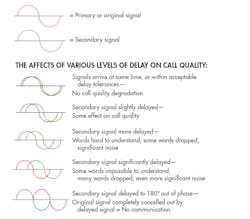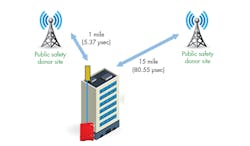Download this article as a .PDF
Critical as voice communications are for first responders, time-delay interference (TDI) is a technical effect that could potentially disrupt this vital link. Reducing the effects of TDI should therefore be a priority for all system integrators and design engineers who want to achieve maximum reliability for voice communications systems used in emergencies. In a distributed antenna system (DAS) for in-building wireless networks, there are several ways to reduce TDI to make sure first responders have a clear voice channel in any situation.
Antenna isolation, system delay, and DAS “dominance” are some of the more important ways of mitigating TDI effects. Those will be explored further, but first, a review of the TDI causes will enable a greater capacity for problem solving.
All public safety systems, whether analog or digital, have the potential to suffer from TDI, which is the byproduct of a radio receiver or DAS antenna receiving multiple “copies” of the same signal at different times. Every simulcast public safety network will introduce time delays. This interference cannot be eliminated completely. However, there are ways that the effects of delay can be controlled.
Figure 1 shows how TDI affects the signal quality. The RF signals are represented here as a waveform.
1. This figure illustrates how call quality is impacted by different extents of time delay.
In approximately 5.37 µs, radio signals travel one mile. In Fig. 2, the signal from the donor site one mile away will reach the target building much earlier than the signal from the donor site 15 miles away.
2. A radio signal from the donor site one mile away will reach the target building much earlier than the signal from the donor site located 15 miles away. A two-way radio inside the building can receive and process both signals, but at different times, creating delay and causing quality issues.
However, there is always a chance that the signal from a donor site located further away will be strong enough to penetrate the building. TDI negatively impacts call quality when a first responder radio inside a building receives and processes both signals because one signal will be greatly delayed.
And to make things even worse, if the structure has an in-building coverage enhancement system, (i.e., DAS), there is a strong likelihood that the first responder radio will attempt to receive and process three signals: one from the DAS and one from each of the two donor sites. This compounds the TDI situation and makes call quality even worse.
There are a number of ways to mitigate TDI effects on a public safety DAS system in order to minimize the delay levels to an acceptable level.
Solution providers and DAS installers should offer the following items to ensure public safety call quality:
- Ensure appropriate isolation between the interior service antennas installed in the building, either by adjusting the quantity and physical location of the antennas or by making adjustments in the signal levels delivered to the antennas in what is called “link budgeting.” A good design for 700/800 MHz DAS systems calls for isolation of 47 dB; UHF systems call for 42 dB of isolation; and VHF calls for 33 dB of isolation.
- Keep system delay as low as possible. System delay within the DAS system can come from the active equipment. It can also stem from passive components like splitters and couplers, and especially from filters that may be required to accommodate the specific channel requirements. The majority of the 800-MHz networks in use today are P25 Phase I or Phase II. These services require a maximum allowable delay between 15 µs for Phase II to 33 µs for Phase I.
Many commercially available bi-directional amplifiers (BDAs) used in public safety DAS systems are available as Class A narrowband devices that can provide delays as low as 15 µs. However, Class B devices provide delay figures as low as 6.5 µs. The solution provider who is deploying BDAs will select the correct model (Class A or B) depending on several criteria, including the desired delay level.
To reduce delay, designers must decide between two possible DAS configurations:
- One that meets the maximum tolerable delay levels through the methods described above, or;
- One that asserts “dominance” over the signal from the macro towers that might be penetrating the building.
If the best available delay level of the DAS exceeds the maximum figure that can be tolerated, the DAS must be configured for dominance. Increasing the strength of the RF signal that emanates from the DAS antennas allows it to become stronger than the RF signal from the macro tower that is penetrating the building—i.e., the DAS is “dominant” over the penetrating macro signal.
A two-way radio receiver is designed to “reject” the weaker signal. So when a DAS is configured for dominance, the weaker signal from the penetrating tower will not cause TDI problems. An engineer configures this by measuring the strength of the penetrating tower signal, and then calculating how much stronger the signal from the DAS antenna needs to be so that it rejects the weaker one.
Figure 3 indicates the amount of signal level dominance required in order to overcome the TDI issues.
3. Time delay calculation charts from “National Public Safety Telecommunications Council (NPSTC)—Best Practices for In-Building Communications—Appendices A through E,” November 12, 2007.
Regardless of what type of in-building DAS systems are in play, the macro network also experiences TDI problems. For example, let’s say that if instead of having a building in between the two donor towers (refer to the diagram in Fig. 2), we have a mobile vehicle or handheld radio. The receiver picks up both signals, but one is delayed. Hence, the negative effects on call quality will occur.
To minimize this “open air” TDI problem, the macro network designer and operators will attempt to design a network where the areas covered by the towers do not overlap. To accomplish, they will do one or more of the following:
- Determine the number of tower sites required to provide good coverage without overlapping each other
- Align the donor tower antennas horizontally (left to right) to more precisely align the coverage areas
- Adjust the tower antennas vertically (tilt up or down) to more precisely align the coverage areas
- Select the appropriate size transmitter for the towers (these typically range from 35 to 100 watts of effective radiated power)
- If the macro network is digital, an additional adjustment for overcoming TDI is to intentionally introduce delay on the signal from the closer tower so that it arrives at the same time as the signal from the tower that is farther away.
TDI is inescapable, but knowing how to mitigate its effect can lead to a stable in-building public safety communications DAS system and ensure stable voice communications for first responders.




